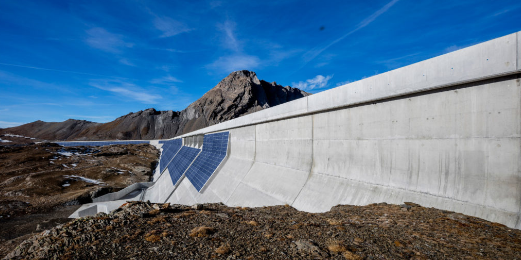From pv magazine Germany
There are already several studies showing that PV systems in mountainous regions can produce a lot of electricity, even during the winter. Switzerland’s Axpo wants to prove this by building a 2 MW plant on the wall of a dam at the Muttsee reservoir, at an altitude of almost 2,500 meters. The company also plans to present the project to the Swiss Federal Office of Energy as an innovative project.
The facility will include around 6,000 modules, deployed across an area spanning roughly 10,000 square meters, the company said, adding that the inclination of the upper module array will be 77 degrees, while the inclination of the lower array will be set at 51 degrees. The plant is expected to generate around 2.7 GWh of solar power per year. Axpo said it is still talking to potential partners about buying the electricity via long-term power purchase agreements.
“The Muttsee dam is extremely well suited for photovoltaics,” said Christoph Sutter, head of renewable energies at Axpo.
Sutter described the site as particularly ideal, as the dam faces south and it has a grid connection. The altitude will also boost solar production, he claimed. The company expects the system to deliver about half of its annual electricity production throughout the winter months, versus about a quarter of annual production for plants of comparable size in Switzerland’s relatively flat lowlands.
The absence of fog is one of several advantages for high-altitude projects, as clear skies mean more solar radiation. The modules are also more efficient in low temperatures, on top of the advantages of the bifacial effect from the snow.
Switzerland consumes significantly more electricity in the winter than it produces. And purchasing electricity during the winter is expected to become more difficult over the next few years, when a number of large power plants in Switzerland and other countries start to go offline.
In recent years, a number of PV systems have been built on the Swiss Plateau, but they have not been effective in resolving the wintertime electricity problem. However, Axpo believes high-altitude PV systems could support the Swiss government’s Energy Strategy 2050.
“We see that photovoltaics can produce large amounts of electricity,” said Andy Heiz, the company’s head of production and grids. “To make a significant contribution, of course, the plant on the Muttsee dam is not enough. We would have to bring these projects to locations that are not in protected areas and are already well developed. However, the political and economic conditions must also be right.”
A recent study by Switzerland’s WSL Institute for Snow and Avalanche Research SLF and the Swiss Federal Institute of Technology in Lausanne highlighted the potential of alpine PV systems. The researchers claimed that such systems could help to mitigate seasonal declines in power generation during the winter due to fog, clouds and lower solar radiation levels.
Swiss energy provider Romande Energie recently built a 448 kW floating solar array on the surface of Lac des Toules, a reservoir located at an altitude of 1,810 meters in the Swiss Alps.
Swissolar, the country’s PV industry association, said this week that the nation needs 50 GW of cumulative installed PV capacity to meet its future energy needs, as a replacement for fossil fuels amid the phase-out of nuclear capacity. That amount of solar is 25 times more than the country has already installed to date.
“We need 40 to 45 TWh of solar power annually, which we can produce for the most part on our roofs and facades,” said David Stickelberger, managing director of Swissolar.
However, the Federal Council and the Federal Assembly will have to create the right conditions to facilitate the deployment of more PV systems – especially on buildings.






